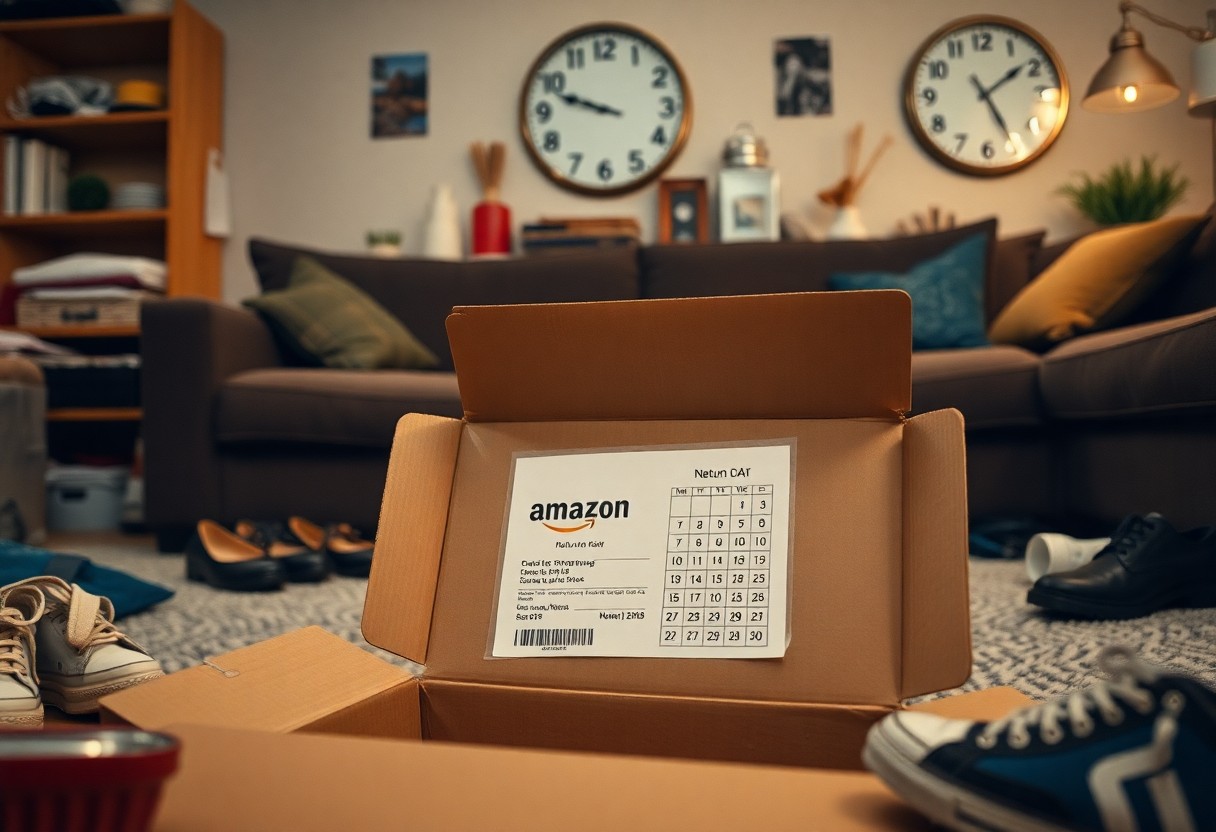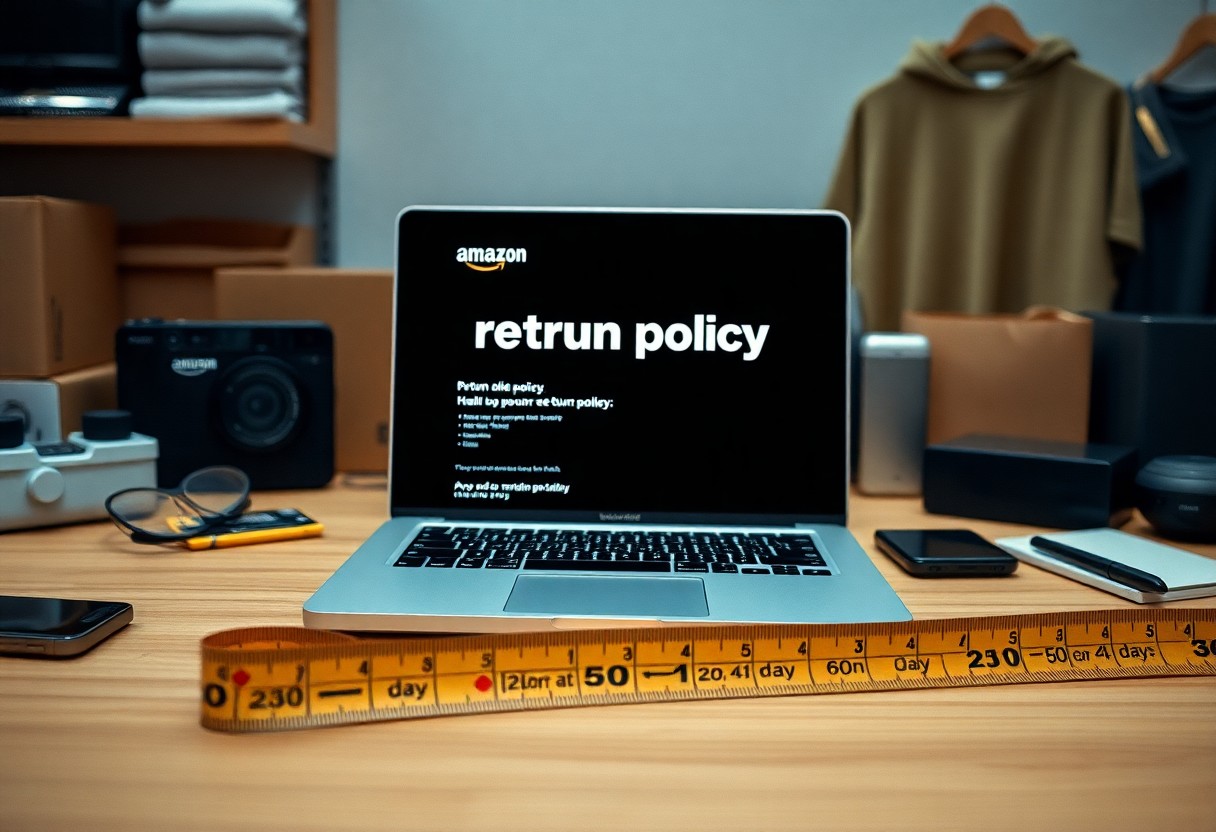You can take advantage of Amazon’s 60-day return policy to ensure satisfaction with your purchases. This policy allows you to return most items within 60 days for a full refund or exchange, provided that they are in original condition. However, be aware that certain categories, like electronics or opened software, may have different rules. To avoid any unpleasant surprises, it’s wise to check the specific return details for each item before you complete your purchase.

Navigating the 60-Day Return Window
Key Dates and Deadlines
The 60-day return window begins the moment you receive your order. You must initiate the return process within this period to be eligible for a refund or exchange. Keep an eye on your order confirmation email; it usually contains the exact date your return window closes. If you return an item after this period, you may lose your right to a refund, meaning you’ll have to deal with a potential store credit instead.
Tracking your returns can also save you headaches later. Each return is typically linked to your Amazon account, allowing you to easily check the status. If you plan to return multiple items, doing so as quickly as possible is beneficial, as each item can have different return processing times. Always print your return label from Amazon’s website to ensure you have proof of return shipment.
Product Categories with Special Rules
Certain product categories have distinct return policies that can affect your experience. For example, items like electronics, opened video games, and some clothing might have specific return requirements or shorter return windows. Additionally, hazardous materials and perishable goods, like food items or plants, are generally not returnable. Be sure to read specific descriptions on the product page for these unique rules.
High-value products, such as furniture or large electronics, often come with specific return guidelines, potentially requiring product inspections or restocking fees. Ensuring that you closely follow these guidelines is vital to avoid incurring unexpected costs or losing the chance to return altogether.
The Steps to Return an Item
Initiating the Return Process
To start the return process, go to the Amazon website or app and navigate to your orders. Find the item you wish to return and select the “Return or Replace Items” option. You’ll be presented with the reasons for return, such as “No longer needed” or “Received the wrong item.” Choose a reason that best reflects your situation, as this helps Amazon improve its services. After you select the reason, follow the on-screen instructions, which will guide you through generating a return label.
Once you have completed your return request, you will receive a confirmation email along with the necessary return label. Make sure to print this label as it must be attached securely to the package before shipping. Keep in mind that you may have to process the return via different methods depending on whether the item was sold directly by Amazon or a third-party seller.
Packaging and Shipping Guidelines
Careful packaging is important to ensure that the item arrives in good condition. Use the original box whenever possible, as it is designed to protect your product. If you no longer have the original packaging, a sturdy box or padded envelope will suffice, but be sure to wrap the item securely to avoid any damage during transit. Include all accessories, manuals, and any other items that came with the product, as returns without these may incur a restocking fee.
The address on your return label should be clear and legible. For best results, tape the label down securely and use packing tape rather than masking or duct tape, as the latter may not hold up well in transit. After sealing the package, choose a shipping method, which may include dropping it off at a nearby UPS or Amazon return center. Verify the tracking information after shipment so you can confirm the return’s progress.
In addition, check for any specific guidelines related to your item type, as certain products have unique return requirements. Electronics and items with hygiene seals, for example, may have stricter conditions. Ensuring compliance with these guidelines can facilitate a smoother return process and expedite your refund once the item is received and inspected.
Understanding Refunds and Exchanges
Refund Methods Clarified
When you initiate a return, Amazon typically processes refunds to the original payment method used for the purchase. If you paid with a credit card, the refund appears back on that card, usually within 3-5 business days after the return is processed. In some cases, if a gift card was used, the refund will be credited back to your Amazon account balance, letting you use it for future purchases. This seamless method ensures you don’t lose out on funds spent.
For items marked as “fulfilled by Amazon,” refunds are processed more quickly, while third-party seller returns might take a bit longer due to their own processing times. Understanding this timeline helps you set expectations around when you can access your funds again, especially if you are relying on them for another purchase.
Situations That May Affect Your Refund
Two significant factors can influence the speed and amount of your refund: the item’s condition and the reason for the return. If you return an item in a condition that does not meet Amazon’s standards—such as being damaged or missing parts—you may be subject to deductions from your refund. For instance, electronics returned without their original packaging or accessories often yield a lower refund amount.
Another aspect that may impact your refund relates to the return reason you selected during the process. Returns for defective or misrepresented items usually result in a faster, full refund. However, returns for buyer’s remorse, where you simply change your mind, may not return the entire amount, particularly if the item has been opened or used.
Additionally, items with specific return policies, like certain electronics or personal care items, might face stricter criteria for refunds. It’s beneficial to review the return policy for each specific product you are purchasing since variances exist that can affect your overall return experience.

The Implications of the Return Policy
Consumer Behavior Insights
The 60-day return policy significantly influences your shopping decisions on Amazon. Studies show that extended return windows can increase purchasing confidence, leading you to buy more products, as you feel a sense of security in case of dissatisfaction. On average, consumers report that they are willing to spend up to 50% more when they know they can return items easily. This behavior has led to an uptick in impulse purchases, which can result in both satisfaction and occasional buyer’s remorse.
Your willingness to buy is further compounded by the ease of initiating returns. With online shopping becoming second nature, the hassle-free return process encourages you to experiment with products you might not have previously considered. This can lead to greater brand loyalty when retailers offer flexible return options, importantly changing how you interact with e-commerce platforms.
The Impact on Sellers and Vendors
For sellers and vendors on Amazon, the 60-day return policy poses both challenges and opportunities. While it drives higher sales volumes due to increased consumer confidence, it also pushes sellers to ensure that their products consistently meet quality expectations. Products that generate frequent returns can negatively affect seller ratings and visibility on the platform, which directly impacts overall sales performance.
Furthermore, sellers must calculate the costs associated with returns, including shipping fees, restocking expenses, and potential losses from damaged goods. Adjusting pricing strategies or offering incentives such as deals on future purchases can mitigate some of the financial implications tied to returns. An effective approach may include investing in clearer product descriptions and higher quality control to reduce return rates.
Common Myths and Misconceptions
Misunderstood Policies Explained
Your understanding of Amazon’s return policy may be clouded by common myths. One prevalent myth is that all items can be returned within 60 days, regardless of their condition. In reality, while most products are eligible for return within this timeframe, specific categories like opened electronics or items not in original packaging often have stricter rules or may not be returnable at all. Additionally, some sellers on the platform have their own tailored return policies, which may differ from Amazon’s standard terms.
Another misconception revolves around the concept that returns result in immediate refunds. Although refunds are prompt, they are contingent on the processing time of your return, which may take a few days after the item is received. The funds reflect back to your account only after Amazon confirms that the returned item is in acceptable condition, meaning the entire process may vary based on your bank’s policies.
Real-Life Scenarios to Consider
Considering various scenarios helps clarify the implications of the return policy. For instance, if you buy a dress for an upcoming event, the 60-day window ensures that if it doesn’t fit as expected, you can return it after trying it on first. However, if you obtain a non-returnable kitchen appliance that you find defective, this presents a challenge since certain items necessitate checking the return policy specifics before purchase. These nuances impact your shopping confidence and decision-making process.
In another scenario, you may order a gadget on Prime Day expecting significant discounts, only to find that it doesn’t match the seller’s return conditions. This situation underscores the importance of reading product descriptions thoroughly, as many items marked as “Final Sale” or with limited return windows may not qualify for the standard 60-day policy. By being informed about the policies related to different categories, you can navigate potential pitfalls and make better-informed purchasing decisions.
To wrap up
From above, you can see that Amazon’s 60-day return policy offers you the flexibility and convenience needed when shopping online. This policy allows you to evaluate your purchases and decide if they meet your expectations without the pressure of a short timeframe. The breadth of items eligible for return under this policy gives you peace of mind when making a decision to buy.
You can take advantage of this extended return window to ensure that your purchases align with your needs. By understanding the terms and conditions associated with Amazon’s return policy, you can streamline your shopping experience and minimize any potential complications if a return is necessary. Ultimately, your satisfaction is a priority, making the process smooth and user-friendly.
FAQ
Q: What is the Amazon return policy for items returned within 60 days?
A: Items returned within 60 days of receipt may qualify for a full refund. The item must be in new and unused condition, and you must provide proof of purchase.
Q: Are there any exceptions to the 60-day return period on Amazon?
A: Yes, certain item categories have different return policies. For example, electronics may have a shorter return window, while items like clothing and accessories may still adhere to the 60-day policy provided they are unworn and with tags.
Q: How do I initiate a return for an item within the 60-day window?
A: To initiate a return, go to Your Orders on the Amazon website or app, select the item you wish to return, and follow the prompts to print a return label and choose your return method.